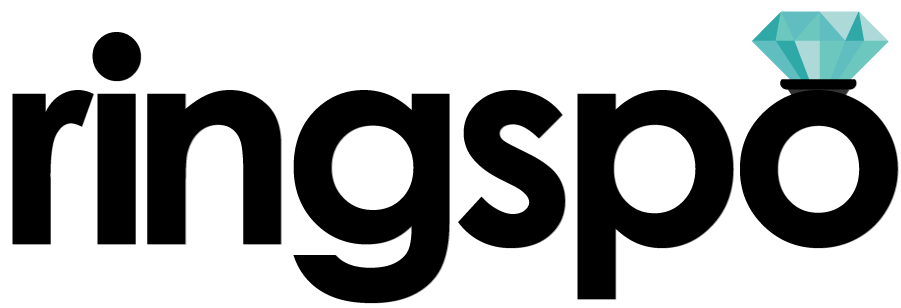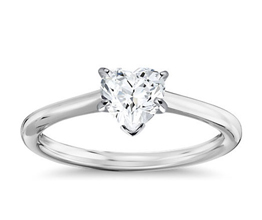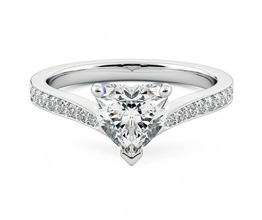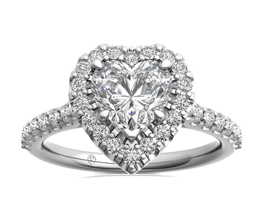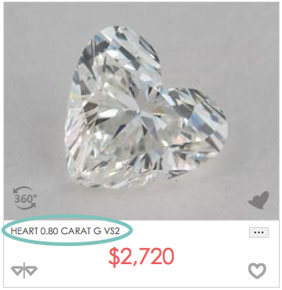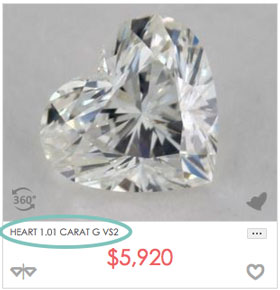Heart shaped engagement rings
How to get the best heart diamond ring for your budget
Ringspo is reader supported
Ringspo is reader-supported, which means we may receive a commission if you click a link to a retailer & subsequently make a purchase.
We feature links to several retailers to help readers find the one that is the best fit for them. Find out more about how Ringspo works here.
Heart shaped engagement rings are a less common choice, but they can be one of the most beautiful shapes of diamond out of any.
However, because there is so much skill needed to cut a heart diamond well, and so much variety in the quality of the diamonds, they can be tricky to buy.
We’re going to look at:
- What’s good about heart shaped engagement rings
- What’s bad about heart engagement rings?
- Heart shaped engagement ring setting styles
- A heart shaped diamond buying guide to tell you what you really need to know
- Recommended specs
Do you know the 4Cs?
Much of the information on this page will focus on diamonds, as getting that right is key to getting an awesome ring for a great price. If you’re not familiar with the 4Cs of diamonds then I’d recommend reading this page which gives an overview of what you really need to know.
Luckily for us, heart shaped diamonds often come about as a result of a ‘happy accident’.

Often if a stone that was destined to become a pear shaped diamond has a large flaw in the top ‘lobe’ the diamond cutter who is shaping the gem will cut into the end, trimming out the inclusion and giving a win-win scenario. The jeweler now has a perfect stone and you get the opportunity to buy a heart shaped diamond engagement ring.

While the first heart shaped diamonds were created over 100 years ago, it wasn’t until the advent of 3D scanning and laser cutting technology that heart shaped diamonds were able to be created with ‘brilliant’ facets, which are calculated to reflect as much light as possible back to your eye.
This is what you are looking for – a stone that sparkles as much as possible, rather than one that has just been cut to hit a certain carat weight. It’s much more impressive to have a 0.8 carat stone which sparkles brilliantly than a 1 carat stone which is dull and lifeless.
What’s good about heart shaped engagement rings?
Heart-shaped diamonds are well-priced
Diamonds that aren’t the traditional round shape are known as ‘fancy’ shapes, and the heart is probably the fanciest of them all. As with all fancy shapes, there’s a huge plus that the heart offers over round brilliant shaped stones and that’s the price.

The table below shows the price difference at one of our recommended retailers between a round brilliant diamond, the most common shape and an emerald cut diamond of the same size and quality:
- 1 carat
- Color F
- Clarity VS1
Here’s how they compare:
| SHAPE | PRICE (US$) | DIFFERENCE (US$) | DIFFERENCE (%) |
|---|---|---|---|
| Round Brilliant | 6,610 | ||
| Heart | 4,938 | -1,672 | -25.3 |
That’s a huge 25% saving for choosing a heart shaped engagement ring over a ring with a round brilliant diamond, which is definitely not to be sniffed at.
You can check out the difference for yourself and see today’s prices for heart diamonds here
Heart diamonds are unique
The other big positive is the uniqueness of heart engagement rings. They make up just 0.5% of all rings sold, so you can be sure that you won’t see a similar ring on every left hand or in every ‘he asked, I said yes’ instagram post.
What’s bad about heart shaped engagement rings?
There are many low-quality heart-shaped diamonds out there
The biggest negative with heart shaped engagement rings is the lack of supply of high quality diamonds. As mentioned earlier, heart shaped diamonds are often created only when there is an issue with a rough diamond that means that another shape won’t work. You may need to look a little bit harder to find a high quality diamond for your stone.
Because of their shape, heart-shaped diamonds can result in a high proportion of the original rough diamond being lost in the cutting process. Diamond cutters are therefore keen to ensure that the stone stays as large as it possibly can, as the carat weight of a stone has a big affect on the amount that a diamond can be sold for.
This can mean that the ‘optical performance’, or how well the stones reflect light back to your eyes and sparkle, is often a secondary consideration. Prioritising size over the cut and sparkle is a sure-fire way to get an unimpressive stone.
This is especially important because hearts shaped diamonds can be prone to the ‘bow tie’ effect, which affects several other fancy shaped stones. The bow tie effect is a dark area that can sometimes be seen on the top of a diamond, where sections of light are absorbed and a bow tie-shaped dark shadow can be seen.
Heart diamonds can easily snag on things
One last thing to be mindful of is that the sharp point of heart shaped engagement rings may be get snagged in clothing or hair. If the stone hasn’t been set securely then this could even mean that the stone is lost. However, the next section details recommended shapes for heart diamond rings which should prevent this.
Heart Shaped engagement ring settings
With heart shaped engagement rings, you should be looking for a setting that is going to show off the stone as much as possible – you want people to know that it is indeed a heart that you’ve chosen and not one of the more common shapes.
In this section we’ll look at a selection of the settings available for your heart shaped ring. If you’d like to know more about any of the rings, just click through on the image or the link to find out more about and to see more heart shaped diamond engagement ring settings too.
Heart shaped diamond solitaire engagement rings
Solitaire settings hold the diamond with either two or four prongs on the sides of the diamond and then a V-shaped prong which holds and protects the point of the heart. The five prong setting (four on the sides and one on the the v-shape) is usually used for stones above 0.7 carats to ensure that the stone is held securely.
The solitaire setting is the best way to ensure that light can enter your stone from any angle, to ensure that it sparkles as much as possible.
Scroll through and click through to find out more and check the price of each setting.
Pavé heart shaped diamond engagement rings
Pavé settings use much smaller stones to ‘pave’ the ring band with diamonds.
The size and number of ‘melee’ diamonds used in a pavé setting can make a big difference to the cost of the setting.
Halo heart diamond engagement rings
Halo settings can serve a dual-purpose for heart-sharped diamond rings.
As well as increasing the visible size of the ring and amplifying the heart shape, they can also give the delicate edges a measure of protection from being damaged if the delicate edges get knocked.
Heart shaped diamond buying guide
As mentioned, heart shaped engagement rings are pretty much the rarest shape out there, so it’s unlikely that your local jeweler is going to have a wide selection in stock for you to examine and compare. I’d therefore definitely recommend buying online, where retailers will have hundreds of stones for you to choose from.
This guide is going to tell you what to look out for when choosing a heart engagement ring to make sure that you get a great stone that sparkles as much as possible.
Heart shaped diamond cut quality
Although there is no set cut grading scale for heart shaped diamonds like there is with round brilliant diamonds, there are a couple of things to look out for to make sure that you get a great looking stone.
Length / width ratio
The length / width ratio is, unsurprisingly, the ratio between how long the stone is and how wide it is. For a heart, the deal length to width ratio is 1 to 1 ie. it is as long as it is wide
Going much lower than this will give you a chubbier looking stone, while longer will look longer and lankier.

Heart Diamond Symmetry
Symmetry is graded on a scale from poor to excellent, and you should go for as high a symmetrical grading as possible to ensure that the stone has a consistent outline and isn’t lopsided. Each of the rounded lobes should be an equal sized and semi-circular, with no straight lines, and the indent between them should be directly in-line with the pointed tip.

Poor symmetry – the ‘wings’ at the side or the stone are uneven and the indent is slightly off-center

Excellent symmetry and a pleasing shape
The exact shape of the heart can only really be seen when an image of the actual stone that you are considering purchasing is examined. Luckily there are some retailers which have high quality images of each of their stones like James Allen and Blue Nile. Click through to check out their wide range of heart shaped diamonds.
Heart Diamond Depth Percentage
Depth percentage is the ratio of the depth to the width of the stone.
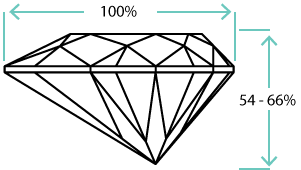
It has a less obvious effect on the overall appearance of an oval diamond compared to some other shapes, but does play a big part in how prominent the bow tie effect is. It can also affect how much light is reflected back to your eyes and therefore how much the diamond will sparkle.
If possible, aim for a depth % within the ‘excellent’ range, below:
|
Excellent |
Very good |
Good |
|---|---|---|
|
54% – 66% |
53% – 72% |
52% – 76% |
Heart Diamond Table percentage
The ‘table’ of a diamond is the large, flat area on the top of the stone.

The size of the table in relation to the rest of the stone is important because the table is where the majority of light enters the stone. This needs to be carefully balanced with the other proportions to ensure that the correct amount of light enters the stone to allow for maximum sparkle. A larger table is not always better.
If you can, look for a heart shaped diamond with a table percentage within the excellent range below to ensure that you get the best sparkle. The ‘very good’ table range will also mean that your diamond will perform well.
|
Excellent |
Very good |
Good |
|---|---|---|
|
54% – 64% |
52% – 66% |
50% – 68% |
The best way to use the above percentages is to enter them into the ‘advanced’ options on online jewelers search tools so that you only see stone that fit within the desirable specs. If you can, try and get ‘excellent’ for both depth percentage and table percentage to ensure that your stone sparkles as brilliantly as possible.
Heart diamond color
Much like football, the heart shape is a game of two halves. At one end, the rounded end, the stone should give off great sparkle due to the brilliant cut facets reflecting light back to your eye. This is great because it can distract and hide minor imperfections and a lower color grade.
However, as with other stones that end in a point (marquise, pear etc), the heart shape is more likely to show a concentration of color at the tip of the stone, and this area won’t have the sparkle to hide it. For this reason, I would recommend a G as the minimum color grade if you want your stone to appear white. Obviously you can go higher than this if you want, but the difference will not be hugely noticeable once the stone is mounted. If you don’t mind, or are even looking for, a ‘warmer’ color then you can go lower than G – down to J is safe without the stone appearing noticeably yellow.

E color
Very white, but very expensive

G color
Great mix of white color and value

I color
‘Warmer’ tones are visible
Heart diamond clarity
Heart shaped diamonds tend to show up inclusions slightly more than other stones because of the way the facets are shaped.

We’d therefore recommend going for a clarity of VS2 at the minimum to ensure that the stone is eye clean.

You can of course go higher than this, but it won’t make too much difference to how the stone actually looks when it’s in the ring setting, unless you are examining the stone with a microscope.
You can also go lower than this – down to SI1 or even SI2 – but if you are considering this then you should buy from a retailer that provides you with magnified pics of the stone that you are considering.
Heart shaped diamond carat weight
Carat weight is something that people often get overly hung-up on. They want to choose a stone with a certain carat weight, even if it means that they end up making sacrifices on other, more important attributes of the ring.
The relationship between a diamond’s carat weight and its visible size isn’t always a direct one. When we judge a diamond’s size, we look at it from the top – known as the ‘face up’ position in the jewelry trade. However, much of the weight of a diamond is actually carried on the bottom half of the stone, where it can’t be seen.
The images below show the difference in size for heart shaped diamonds at a range of carat weights:

Hopefully you can see that increasing the carat weight doesn’t necessarily translate into a much visibly larger diamond. Changing the size from 0.8 carat to 1 carat is an increase in width of less than 0.5mm – less than 10%. However, the difference in price will be much more significant – over a 100% increase:
The priority that you place on diamond carat weight and how bit you want to go is totally up to you.
Finding a large heart shaped engagement ring (say, over 2 carats), that has great sparkle can be tough though as most high quality stones of this size are used to make other shapes. But, if that’s what you are after then you may need to add some extra bling by other ways e.g. a channel setting, with extra diamonds positioned in the band.
However, my recommendation is that you definitely don’t make it the most important attribute when choosing your engagement ring. Get the setting you love, find a diamond with a great cut that is going to sparkle brilliantly, make sure that it is eye-clean and has a good color and then see what carat weight you can fit into your budget.
A well-rounded diamond with excellent sparkle will much much more impressive than a big stone with obvious flaws.
Heart shaped diamond certification
The fifth C, and a very important one too. When looking at any diamond, you need to ensure that any diamond that you’re looking at is a ‘cert stone’, which means that it has been assessed, graded and coded with a laser by an independent lab.
Each certificate has a unique report number and detailed information about the stone, covering the four Cs, the height, depth and other info. As well as providing assurance that the stone that you’re buying is the quality that you are paying for, a certificate also proves what you’re buying is not a substitute.
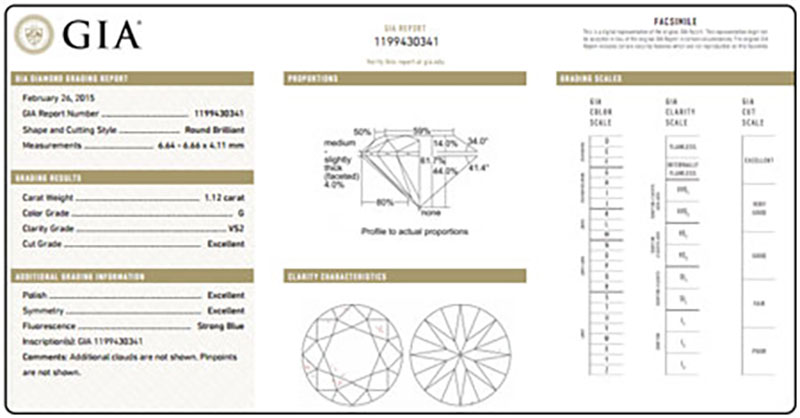
The lab to trust and to look for certification from is the non-profit Gemological Institute of America (GIA). It’s the most internationally recognised and generally seen as the most impartial of all of the gem labs.
The reason that the GIA is so well respected is because most others labs are part of trade bodies that contain jewelry retailers, or are ‘for profit’. While the GIA is very consistent with its gradings, the others have a reputation for being overly generous. What the GIA say is merely a diamond with a ‘good’ cut, maybe be graded ‘excellent’ by another lab, with an excellently large price to match.
Diamond certificates are what makes buying online safe and the best way to get a fantastic diamond at the lowest price. Knowing that each diamond you’re considering has been measured and graded by independent experts allows you to make an informed decision. You can take your time to consider the differences between diamonds and make sure you choose what experts have graded as the best stone, meaning that you get your perfect engagement ring at the best possible price.
Recommended specs
These specs are the minimum that we recommend to ensure that the diamond on your heart shaped engagement ring looks fantastic.
You can of course go higher than these specs, if your budget allows, but for many of the characteristics you are paying for improvements that are very difficult, if not impossible, to see by the naked eye, especially when mounted in a ring setting.
If you’re unsure about what any of these terms mean, check out this page which talks you through them all.
| Clarity: | VS2 |
| Color: | G |
L/W Ratio: Table %: Depth %: | 0.9 – 1.0 54% – 64% 54% – 66% |
